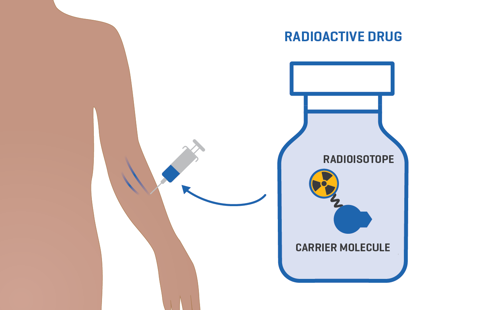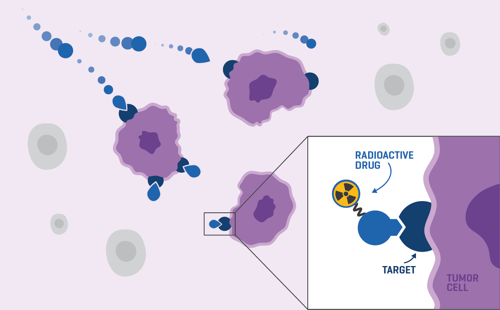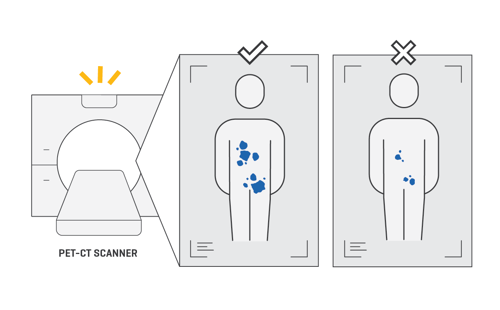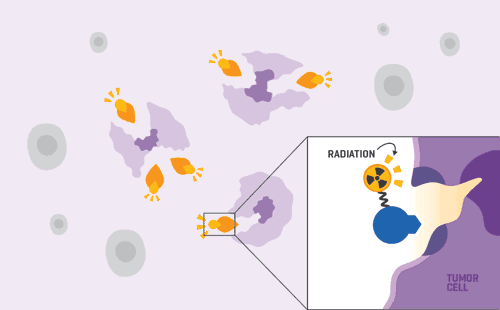What is theranostics?
Theranostics is a personalised form of cancer treatment that combines diagnostic imaging to identify a person’s cancer cells and targeted therapy to treat their cancer. It aims to slow the growth and spread of cancer, relieve symptoms and maintain or improve quality of life. Theranostics may be considered for people with advanced cancer, when standard treatment options are unsuitable or no longer effective and symptoms are affecting quality of life.
How does theranostics work?
The term theranostics comes from the combination of two words – ‘diagnostics’ and ‘therapeutics’. Click through the phased steps below to find out how theranostics works.
Phase 1: Diagnostics
-
During the diagnostic stage, a radioactive drug called a radiopharmaceutical is injected into your bloodstream.
This radioactive drug is made up of a radioisotope which gives off a small amount of radiation, connected to a carrier molecule that can attach to cancer cells.

-
Led by the carrier molecule, the radioactive drug finds and attaches to the cancer cells in your body through a specific target on their surface.

-
The small amount of radiation from the radioisotope then shows up as ‘hot spots’ on a PET-CT scan.
This lets doctors see where the cancer is in your body and can help them decide whether targeted therapy is a suitable treatment option for you.

Phase 2: Therapy
-
For treatment, a similar radiopharmaceutical (radioactive drug) carrying a different radioisotope is injected into your blood stream.
This radioisotope is chosen as it gives off a type of radiation that aims to injure or kill the cancer cells.

-
Once in your bloodstream , the radioactive drug attaches to cancer cells with the specific target.

-
The radiation released from the radioisotope injures and potentially kills the cancer cells, avoiding damage to the healthy cells around them.
Targeting this radiation as much as possible to the cancer cells reduces the potential side effects you may experience from treatment.

What types of cancer can theranostics treat?
Theranostics is an emerging cancer treatment option which has had the most success in treating advanced prostate cancer and neuroendocrine cancers.
Prostate cancer
Icon Cancer Centre provides theranostics for advanced prostate cancer with Lutetium-177 PSMA therapy.
About Lutetium-177 PSMA therapy
Neuroendocrine tumours
We can also provide therapy for selected neuroendocrine tumours with Lutetium-177 DOTATATE therapy.
Is theranostics subsidised under the Medicare Benefits Scheme (MBS)?
Yes, Lutetium-177 prostate specific membrane antigen (PSMA) therapy is listed on the MBS for the treatment of patients with progressive or symptomatic metastatic castrate-resistant prostate cancer, where prior treatment has failed. The whole-body PSMA positron emission tomography (PET) to determine a patient’s suitability to undergo Lutetium PSMA therapy is also subsidised. Find out more on the MBS website under Item 16050 and Item 16055 of the schedule.
Lutetium-177 DOTA-somatostatin receptor therapy is also listed on the MBS for patients with inoperable, locally advanced or metastatic neuroendocrine neoplasms (NEN) who have progressive disease or uncontrolled symptoms despite standard treatment. A whole-body 68Ga DOTA-somatostatin PET scan to confirm suitability for Lutetium therapy is also subsidised. Find out more on the MBS website under Item 16060 of the schedule.
We're here for you, every step of the way.
To learn more about theranostics or find out how to receive this treatment at Icon, please click the button below.
Please note, theranostics is currently only available at Icon Cancer Centre North Lakes, Queensland.





